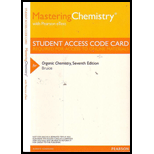
Interpretation:
The reason for the retention of
Concept introduction:
Nucleophile: Nucleophiles are electron rich compounds which donates electrons to electrophilic compounds which results in bond formation.
Nucleophilic nature depends on the negative charge present in the molecule, the solvent in which it present and the electronegativity of the atom.
Electrophile: Electrophiles are electron deficient compounds which accepts electrons from nucleophiles that results in bond formation.
Reduction Reaction: It is just opposite of oxidation reaction which involves removal of oxygen atoms or addition of hydrogen atoms and addition of electrons.
Acid Catalyzed Hydration Reaction: The reaction involves breaking of phi bonds between carbon-carbon multiple bonds and addition of alcohol to more substituted position of carbon in the molecule.
First step is the acid donates proton to the alkene which leads to the formation of more stable carbo cation.
Then, the water is added to the given alkene through acid catalyzed reaction where the water gets added to the carbo cation finally, the removal of one proton from oxonium ion (oxygen with one positive charge) using water results in the formation of product.
Want to see the full answer?
Check out a sample textbook solution
Chapter 6 Solutions
Organic Chemistry - Access
- A problem often encountered in the oxidation of primary alcohols to acids is that esters are sometimes produced as by-products. For example, oxidation of ethanol yields acetic acid and ethyl acetate: Propose a mechanism to account for the formation of ethyl acetate. Take into account the reversible reaction between aldehydes and alcohols:arrow_forwardGenerally, addition of halogen acids to alkene follows Markovnikov rule. In which condition the anti-Markovnikov rule is followed? Describe the mechanism with an example.arrow_forward(1R,2R)-1-Bromo-2-methylcyclopentane is reacted with sodium methoxide. Given the product(s) and show the reaction mechanism, including the depiction of the transition state. Draw an energy diagram for this conversion.arrow_forward
- A mechanism pattern involved in this reaction is loss of a leaving group rearrangement nucleophilic attack substitutionarrow_forwardAnswer the following questions about the mechanism for the acid-catalyzed hydration of an alkene: a. How many transition states are there? b. How many intermediates are there? c. Which step in the forward direction has the smallest rate constant?arrow_forwardCompound K reacted with bromine in the presence of UV light. Predict the free radical substitution mechanism that occurredarrow_forward
- Provide the reaction (reactants -> products) with detailed mechanism for the following, with AlCl3 as catalyst. Indicate if the mechanism is substitution, addition of deletion. Toluene + CHCl3 Benzene + CHCl3 1-Hexyne + CHCl3 3-Hexyne + CHCl3arrow_forwardConsider the substitution reaction that takes place when (R)-3-bromo-3-methylhexane is treated with sodium methoxide. Deduce the mechanism of this reaction working step by step. Write all possible products showing the stereochemistry.arrow_forwardPredict the product(s) of the following reactions, including stereochemistry when necessary and identify the mechanism of each substitution reaction (SN1 vs SN2). Draw the reaction mechanism (reaction arrows) for any one of the reactions to show how the product is formed.arrow_forward
- Although two products (A and B) are possible when naphthalene undergoes electrophilic aromatic substitution, only A is formed. Draw resonance structures for the intermediate carbocation to explain why this is observed.arrow_forwardDraw a detailed mechanism for the FeBr3@catalyzed reaction of ethylbenzene with bromine, and show why the sigma complex (and the transition state leading to it) is lower in energy for substitution at the ortho and para positions than it is for substitution at the meta position.arrow_forwardWhat are the groups towards meta position give examples and what its mechanism ?arrow_forward
 Organic ChemistryChemistryISBN:9781305580350Author:William H. Brown, Brent L. Iverson, Eric Anslyn, Christopher S. FootePublisher:Cengage Learning
Organic ChemistryChemistryISBN:9781305580350Author:William H. Brown, Brent L. Iverson, Eric Anslyn, Christopher S. FootePublisher:Cengage Learning

